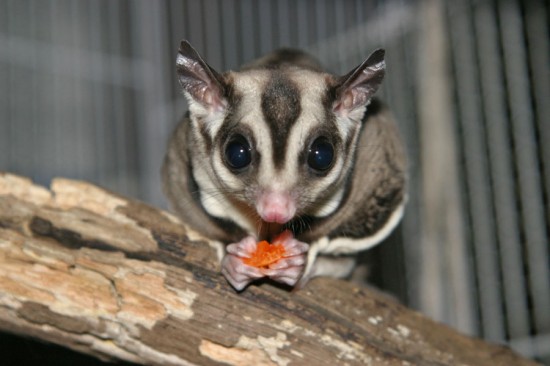

The sugar glider is a small marsupial, a type of gliding possum, which is native to Australia and New Guinea. The glider is becoming increasingly popular as a pet, particularly in the US and the Antipodes, and they are gaining in popularity in the UK too. But what are they and do you want one as a pet?
As already mentioned, the sugar glider is a small marsupial. This means that young animals spend the early part of their life in the pouch. They are slightly squirrel-like and their unusual (yet very cute!) appearance means they are becoming popular as pets.
The name 'sugar glider' comes mainly from their preferred diet. In the wild the animals feed on the sap and nectar of the eucalyptus tree and the flap of skin which connects their wrists and ankles and allows them to 'fly' between trees, lends them the name 'glider'.
As well as feasting on Eucalyptus, the omnivorous glider will also feed on small insects, plants and fruit and that fact that they live in very tight-knit social groups in the wild often means they will quickly form a bond with their owners.
Because the sugar glider is considered an exotic pet, appropriate care and maintenance should be researched thoroughly. They are certainly not a pet for everyone. They will not thrive if they are not provided with plenty of opportunities to socialise and keeping them is even illegal in some countries so it is worth investigating the laws in your country before acquiring your first sugar glider.
Sugar gliders are curious, playful and affectionate little animals and because of this they can make excellent pets. Any owner must be willing to home more than one glider as they are social animals. Plenty of human interaction should also be provided.
Gliders are quite clean do not require a complicated housing set up, and if their basic needs are catered for they can live for anywhere between 12-14 years. As they are essentially a jumping and climbing animal, they will use their claws to cling on and that inevitably means they will use their little talons to grip onto their owner too, so it's worth keeping the claws trimmed. They are not aggressive animals, but they will bite if they feel threatened; having said that, acquiring a tame glider that is used to being handled can often mean that they appreciate regular cuddles.
The sugar glider does have quite strict dietary requirements and experts cannot seem to reach an agreement on what is the best food to offer. As they are quite a new entrant to the pet industry the subject is still clouded in controversy and it can be a matter of trial and error. The animal is prone to metabolic bone diseases which are the result of an imbalance of calcium and phosphorous so this must be a consideration when planning your glider's diet.
The sugar glider's natural diet is hard to replicate in captivity, which has led to the confusion mentioned above, however many experts have recommended feeding a combination of Leadbetter's Mix, zoo-quality insectivore feed or high-quality insects, and a small amount of finely chopped, mixed fresh fruit.
The gliders should be fed once a day in the evening and care should be taken to check that all gliders are getting a fair share of food. Fats and refined sugars should be avoided and any dietary changes should be introduced over a period of a few days to avoid tummy upsets. Chocolate should NEVER form part of a glider's diet as it is highly poisonous.
A pair of gliders should be housed in a mesh (make sure the gaps are no bigger than half an inch) cage that is no smaller than 24" x 24" and at least 36" high. Gliders need plenty of space to jump and climb.
Enrichment should be provided in the shape of horizontal bars, non-toxic plants or branches, next boxes, exercise wheels, toys and a marsupial pouch. The bottom of the cage should be covered in a substrate of shavings (never use cedar) to absorb waste and this should be cleaned out and replaced regularly - at least once or twice a week. Also be aware - gliders are quite intelligent and could work out how to open a loose latch!
The cage should be placed in a warm spot out of direct sunlight.
As with any exotic pet, the best place to get your gliders is from a reputable breeder. Shipped-in animals can suffer greatly with stress and may never truly recover.
Purchasing from a breeder also means you benefit from their experience - a reputable breeder will offer guidance and advice when you take your new friends home. Buying young animals is preferable as they will quickly get used to being handled, however budgetary constraints may not allow for this so be prepared, if you opt for an adult animal, for plenty of bonding time and play.
You maybe able to find Sugar Gliders for Sale sometimes on our pets4homes website, advertised by both private sellers and breeders.
As an arboreal (tree-dwelling) creature, the glider should show no fear of other pets you may have, although that's not to say your existing pets won't see your new friend as dinner! Please be careful when introducing your glider to your other animals. One word of warning though - in the wild gliders will take small birds and love to play with and bite feathers. If you already have birds, they may not thank you for bringing a glider into their lives!
Copyright © 2005-2016 Pet Information All Rights Reserved
Contact us: www162date@outlook.com